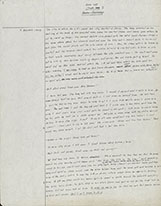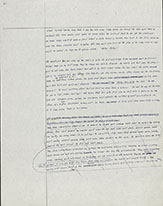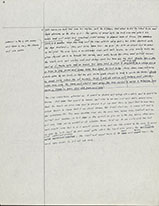|
The extant 17-page manuscript of "Barn Burning" tells at least two stories. As one of Faulkner's cleaner manuscripts, it tells the story of Sarty Snopes' divided longings almost exactly as it appeared in print in the June 1939 issue of Harper's Magazine, and as most readers know it today. But apparently Faulkner himself was conflicted about how to use the story. As you can see on the first page below, in an atypical gesture Faulkner dated this manuscript – "7 November 1938." In his biography, Joseph Blotner speculates this was the day that Faulkner, after an earlier version of the story had been rejected by some magazine, sat down to rewrite it from the beginning, before submitting it again to a different periodical (Blotner, II: 1004). On the other hand, in Reading Faulkner's Best Short Stories, Hans Skei asserts this was the day that Faulkner, having been working for some months on a novel tentatively titled "The Peasants," decided to use "Barn Burning" as its opening section (Skei, 55-57). At some point, as you can see, Faulkner crossed out the short story's title and replaced it with the kind of numbered Book-and-Chapter headings he used in the novel, which was ultimately published, with an entirely different beginning, as The Hamlet (1942). To my eye, the date is definitely, and the new title probably, written differently than the words and numbers on the rest of the page, and so perhaps these three actions (manuscript, date, revised title) occurred at two or even three different times. You can see what your eye tells you.

There's no question that at one stage of The Hamlet's composition, Faulkner did plan to use "Barn Burning" as what he called "an induction" to the story of Flem Snopes. Flem is not named in the manuscript or the published story; it's fascinating to wonder how beginning the Snopes trilogy with this powerful story of his younger brother (who in turn is not named in The Hamlet) might have affected the thematic or emotional arc of the trilogy's narrative. In the novel, Ab Snopes' actions in "Barn Burning" are retold, summarily, by one of the characters. But as we have it, the story's manuscript seems squarely focused on the short story it is telling.
We don't know, however, what we don't have: what manuscripts or at least pages Faulkner may have written prior to this one. The page below right makes it clear that there could have been many such pages. Along with the page below left, these two pages (numbered 15 and 16) show the only untidy part of the manuscript, as Faulkner struggles to figure out exactly how to bring Sarty's story to its ambiguous ending. He wrote the very last page on the bottom half of a used but discarded page, an earlier draft of the passage halfway through the tale where Sarty is "being pulled two ways as between two teams of horses." And in fact, although always referred to as a "17-page" manuscript, the one we have is really 16-pages long; its last page, unnumbered and not included here, is a discarded version of the scene where Sarty breaks free of his mother's grasp and runs toward Major de Spain's house.
 
|

